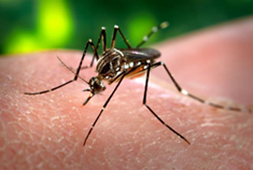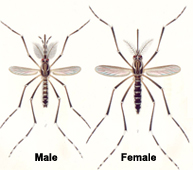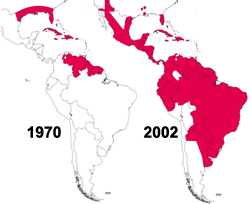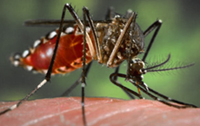The yellow fever mosquito, Aedes aegypti, can spread dengue fever, Chikungunya yellow fever viruses, and other diseases. It is a tiny, dark mosquito approximately 4 to 7 millimeters long, with typical white markings on the legs and a marking in the form of a lyre on the thorax. Females are more significant and can be distinguished by small palps tipped with silver or white scales.


Aedes aegypti is a day-biting mosquito. That means the mosquito is most active during daylight, approximately two hours after sunrise and several hours before sunset. The mosquito rests indoors, in closets, and in other dark places. Outside, they rest where it is cool and shaded. The males of all species of mosquitoes do not bite humans or animals of any species. They live on fruit. The females of Aedes aegypti feed not only on fruit but also on blood. When viewed under a microscope, male mouthparts are modified for nectar feeding, and female mouthparts are modified for blood feeding (see Figure 2). The female needs blood to mature her eggs. Feeding on humans generally occurs at one to two-hour intervals. The mosquito attacks from below or behind, usually underneath desks or chairs, and mainly at the feet and ankles. Aedes aegypti is adapted to breed around human dwellings and prefers to lay its eggs in clean water, which contains no other living species. These eggs become adult in about one-and-a-half to two weeks (see also Life cycle of Aedes aegypti).
Dengue virus-infected mosquitoes have the virus in their salivary glands. When a female Aedes aegypti bites a human for food, she injects saliva into the wound, where the anticoagulants in her saliva facilitate feeding. Without knowing, the mosquito also injects the dengue virus into the host. Since the virus can be passed from adult to egg, the dengue virus can survive until the following summer and heavy rains.
The mosquito originated in Africa but is now globally present in tropical and sub-tropical regions (see also Epidemiology). The mosquito has a so-called cosmo-tropical distribution annually and spreads to more temperate regions during the summer. Living near man, Aedes aegypti has become largely dependent on and adapted to humans. For instance, the mosquito has dramatically reduced the `humming’ sound with its wings. Humans nearly hear Aedes aegypti, unlike other species whose humming is highly irritating and awakens the deepest sleeper. The insect is very fast in flight unless gorged with blood. Different types of mosquitoes even fly into your face and can be easily caught or killed, not Aedes aegypti.
In South America, Aedes aegypti distribution extended from the southern United States to Argentina in the 19th century. The mosquito was nearly eradicated due to the development of a successful eradication program to control yellow fever through mosquito control and manipulation of breeding sites. Though initially successful, Aedes aegypti has been re-established in most parts of South America due to the lack of commitment and financial backing necessary to maintain the eradication program (see Figure 3). The program is no longer operational today. In the United States, the mosquito is found in at least 23 states, including the southeastern U.S., up the east coast to New York, and west to Indiana and Kentucky.


The mosquito Aedes aegypti comes in three polytypic forms: domestic, sylvan, and peridomestic.
- The domestic form breeds in urban habitats, often around or inside houses.
- The sylvan form is more rural and breeds in tree holes, generally in forests.
- The peridomestic form thrives in environmentally modified areas such as coconut groves and farms.